Abstract
OBJECTIVES. This study responds to clinical and research interest in identifying alcohol- and drug-related problems in health and social service agency populations. These problems are associated with a variety of illnesses and social problems, and community agencies serve important screening functions. METHODS. Indicators of problematic alcohol and drug use are compared across representative samples of clients within a county's alcohol, mental health, and drug treatment systems; hospital emergency rooms; primary health clinics; criminal justice and welfare systems; and general population. RESULTS. Agencies followed a consistent rank ordering in the prevalence of substance abuse indicators. Highest prevalences were found in the populations of behavioral health agencies, including alcohol, drug, and mental health treatment facilities and criminal justice, followed by welfare agencies. General medical agencies served populations with the lowest prevalence and problem severity. CONCLUSION. Health and social service agencies provide significant opportunities for the screening and referral of individuals with problematic alcohol and drug use. Although behavioral agencies have higher potential for referral and intervention, general medical services may be more effective in conducting prevention and early case-finding activities.
Full text
PDF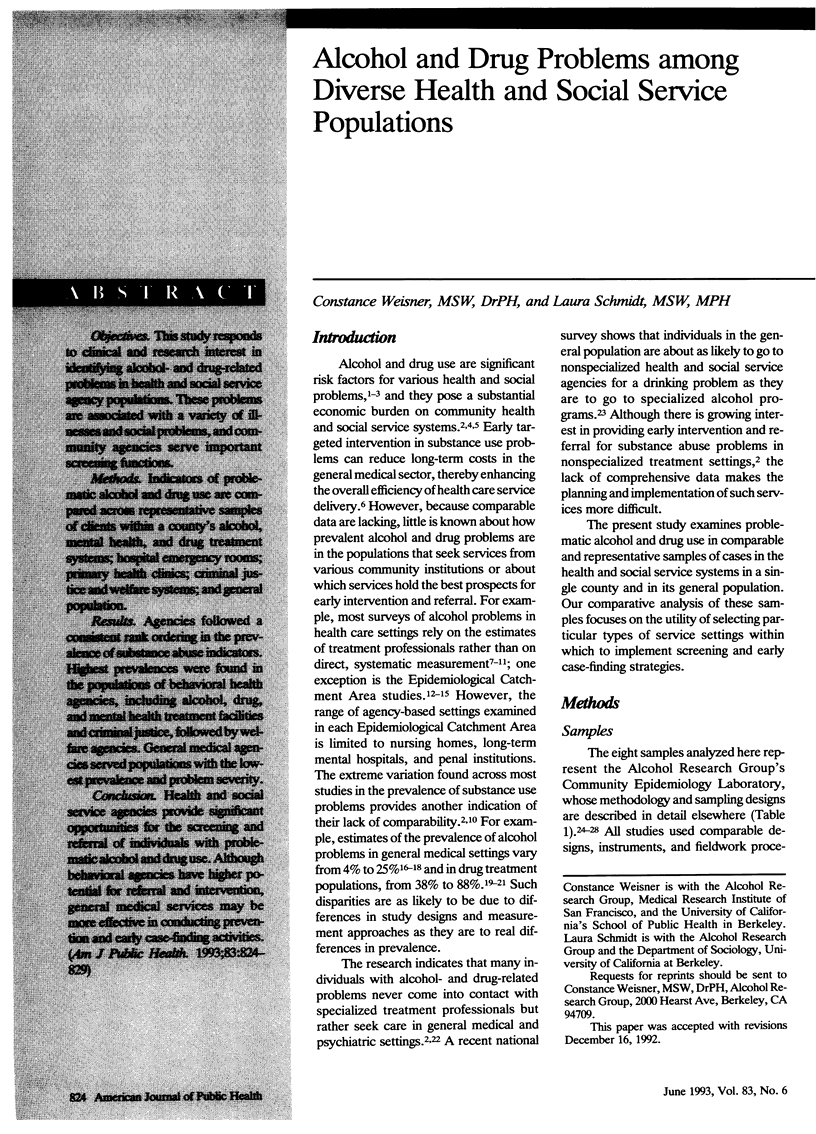
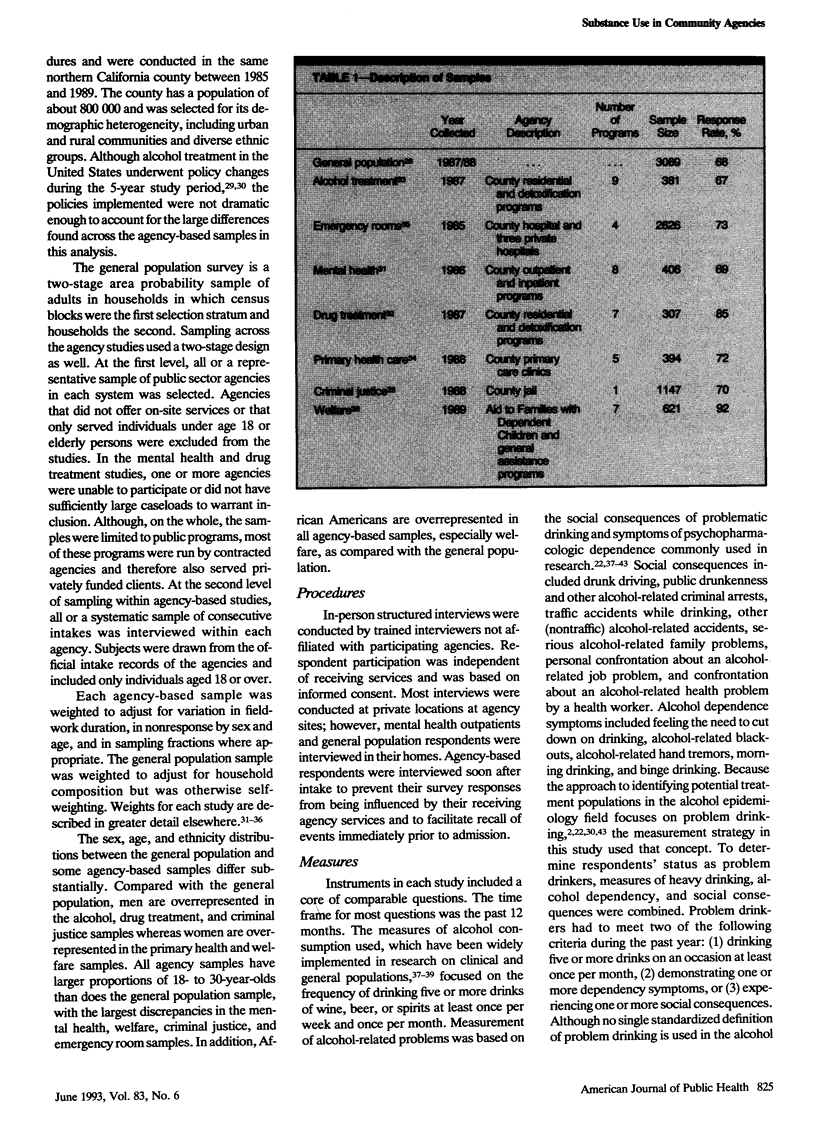
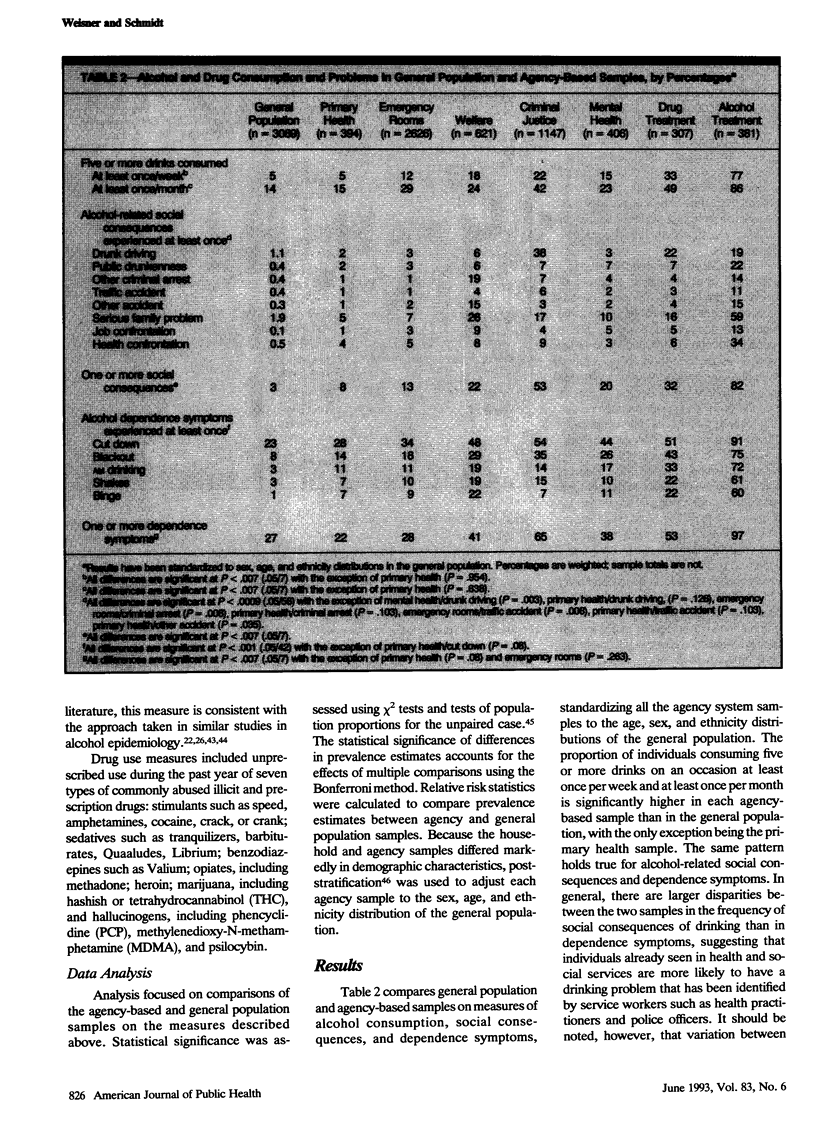

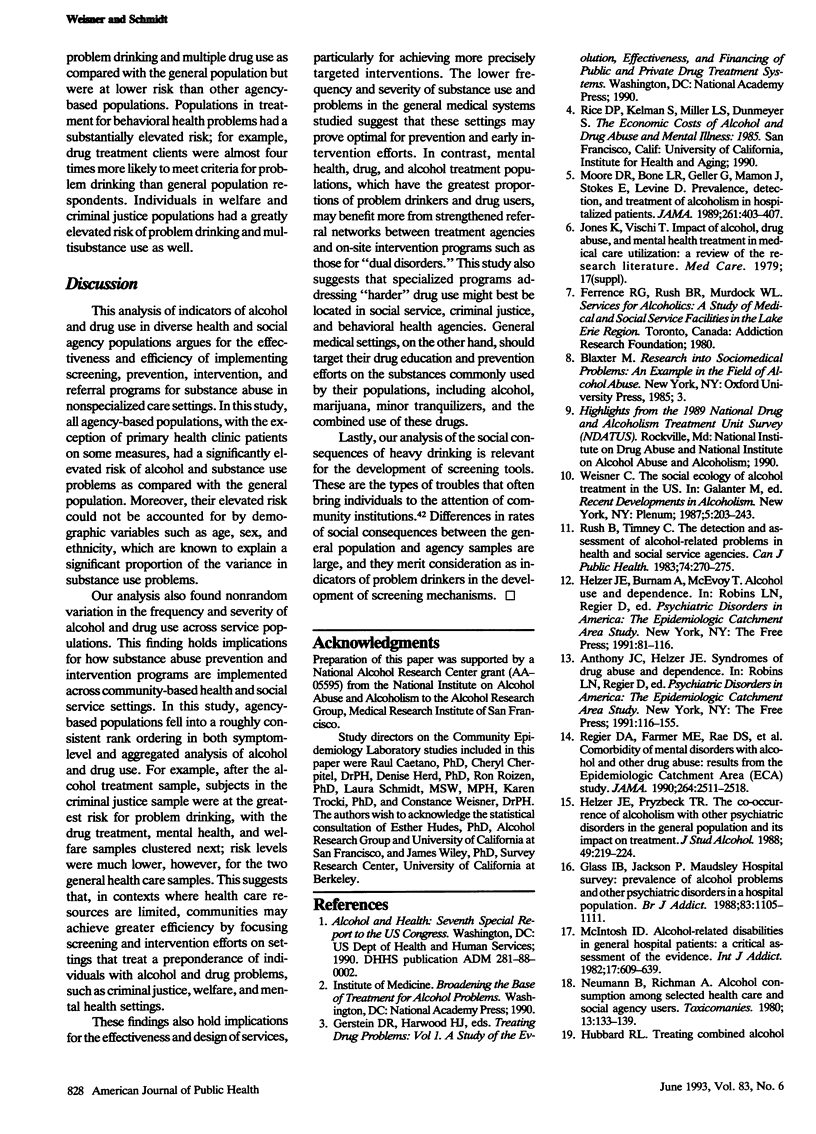
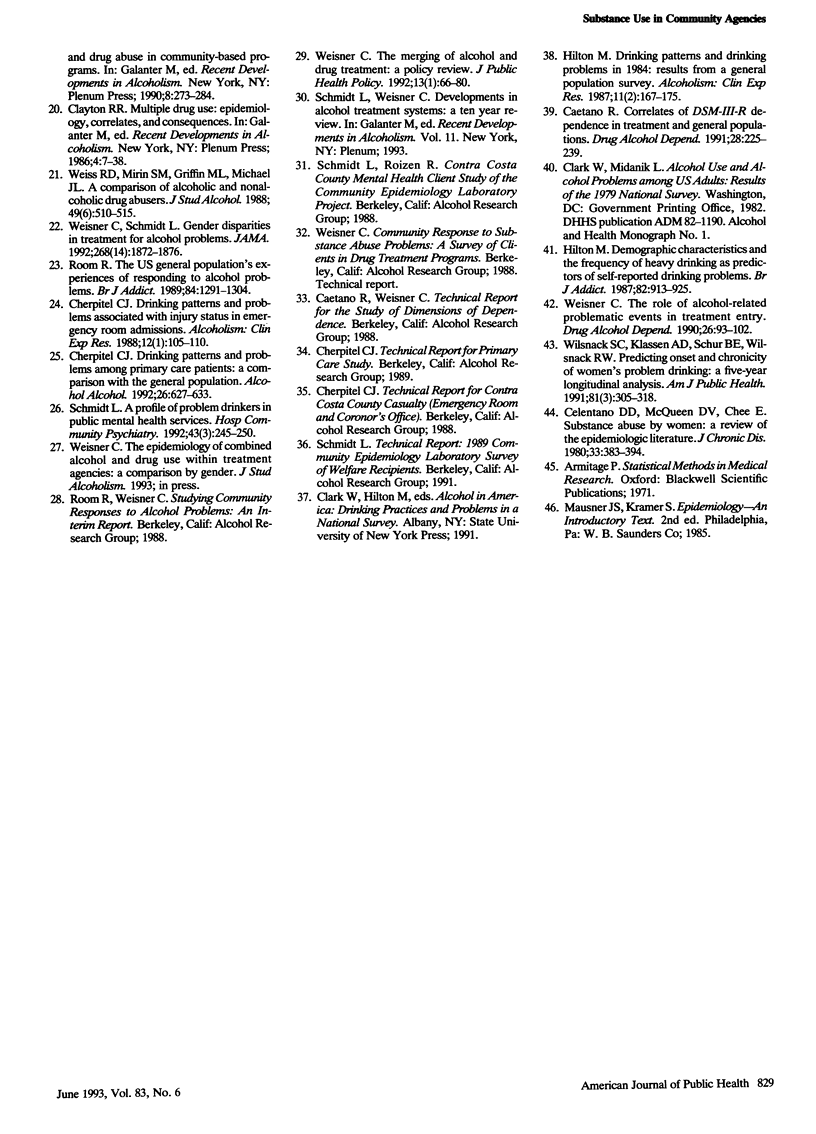
Selected References
These references are in PubMed. This may not be the complete list of references from this article.
- Caetano R. Correlates of DSM-III-R alcohol dependence in treatment and general populations. Drug Alcohol Depend. 1991 Oct;28(3):225–239. doi: 10.1016/0376-8716(91)90056-5. [DOI] [PubMed] [Google Scholar]
- Celentano D. D., McQueen D. V., Chee E. Substance abuse by women: a review of the epidemiologic literature. J Chronic Dis. 1980;33(6):383–394. doi: 10.1016/0021-9681(80)90048-x. [DOI] [PubMed] [Google Scholar]
- Cherpitel C. J. Drinking patterns and problems among primary care patients: a comparison with the general population. Alcohol Alcohol. 1991;26(5-6):627–633. doi: 10.1093/oxfordjournals.alcalc.a045166. [DOI] [PubMed] [Google Scholar]
- Cherpitel C. J. Drinking patterns and problems associated with injury status in emergency room admissions. Alcohol Clin Exp Res. 1988 Feb;12(1):105–110. doi: 10.1111/j.1530-0277.1988.tb00141.x. [DOI] [PubMed] [Google Scholar]
- Clayton R. R. Multiple drug use. Epidemiology, correlates, and consequences. Recent Dev Alcohol. 1986;4:7–38. [PubMed] [Google Scholar]
- Glass I. B., Jackson P. Maudsley Hospital Survey: prevalence of alcohol problems and other psychiatric disorders in a hospital population. Br J Addict. 1988 Sep;83(9):1105–1111. doi: 10.1111/j.1360-0443.1988.tb00539.x. [DOI] [PubMed] [Google Scholar]
- Helzer J. E., Pryzbeck T. R. The co-occurrence of alcoholism with other psychiatric disorders in the general population and its impact on treatment. J Stud Alcohol. 1988 May;49(3):219–224. doi: 10.15288/jsa.1988.49.219. [DOI] [PubMed] [Google Scholar]
- Hilton M. E. Demographic characteristics and the frequency of heavy drinking as predictors of self-reported drinking problems. Br J Addict. 1987 Aug;82(8):913–925. doi: 10.1111/j.1360-0443.1987.tb03912.x. [DOI] [PubMed] [Google Scholar]
- Hilton M. E. Drinking patterns and drinking problems in 1984: results from a general population survey. Alcohol Clin Exp Res. 1987 Apr;11(2):167–175. doi: 10.1111/j.1530-0277.1987.tb01283.x. [DOI] [PubMed] [Google Scholar]
- McIntosh I. D. Alcohol-related disabilities in general hospital patients: a critical assessment of the evidence. Int J Addict. 1982 May;17(4):609–639. doi: 10.3109/10826088209053007. [DOI] [PubMed] [Google Scholar]
- Moore R. D., Bone L. R., Geller G., Mamon J. A., Stokes E. J., Levine D. M. Prevalence, detection, and treatment of alcoholism in hospitalized patients. JAMA. 1989 Jan 20;261(3):403–407. [PubMed] [Google Scholar]
- Regier D. A., Farmer M. E., Rae D. S., Locke B. Z., Keith S. J., Judd L. L., Goodwin F. K. Comorbidity of mental disorders with alcohol and other drug abuse. Results from the Epidemiologic Catchment Area (ECA) Study. JAMA. 1990 Nov 21;264(19):2511–2518. [PubMed] [Google Scholar]
- Room R. The U.S. general population's experiences of responding to alcohol problems. Br J Addict. 1989 Nov;84(11):1291–1304. doi: 10.1111/j.1360-0443.1989.tb00731.x. [DOI] [PubMed] [Google Scholar]
- Rush B., Timney C. The detection and assessment of alcohol-related problems in health and social service agencies. Can J Public Health. 1983 Jul-Aug;74(4):270–275. [PubMed] [Google Scholar]
- Schmidt L. A profile of problem drinkers in public mental health services. Hosp Community Psychiatry. 1992 Mar;43(3):245–250. doi: 10.1176/ps.43.3.245. [DOI] [PubMed] [Google Scholar]
- Weisner C., Schmidt L. Gender disparities in treatment for alcohol problems. JAMA. 1992 Oct 14;268(14):1872–1876. [PubMed] [Google Scholar]
- Weisner C. The merging of alcohol and drug treatment: a policy review. J Public Health Policy. 1992 Spring;13(1):66–80. [PubMed] [Google Scholar]
- Weisner C. The role of alcohol-related problematic events in treatment entry. Drug Alcohol Depend. 1990 Oct;26(2):93–102. doi: 10.1016/0376-8716(90)90116-v. [DOI] [PubMed] [Google Scholar]
- Weiss R. D., Mirin S. M., Griffin M. L., Michael J. L. A comparison of alcoholic and nonalcoholic drug abusers. J Stud Alcohol. 1988 Nov;49(6):510–515. doi: 10.15288/jsa.1988.49.510. [DOI] [PubMed] [Google Scholar]
- Wilsnack S. C., Klassen A. D., Schur B. E., Wilsnack R. W. Predicting onset and chronicity of women's problem drinking: a five-year longitudinal analysis. Am J Public Health. 1991 Mar;81(3):305–318. doi: 10.2105/ajph.81.3.305. [DOI] [PMC free article] [PubMed] [Google Scholar]


